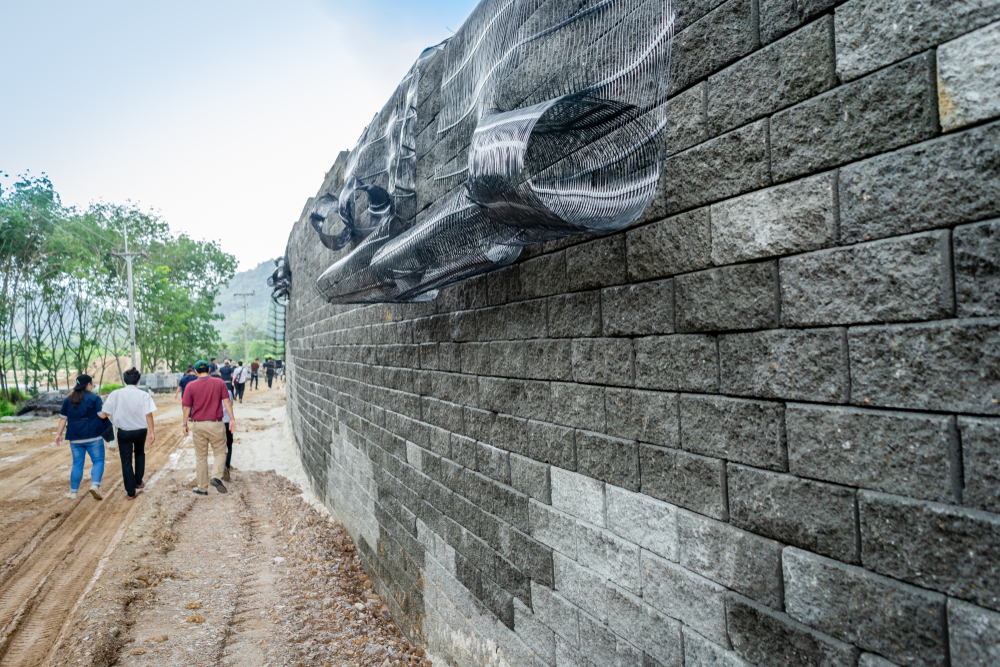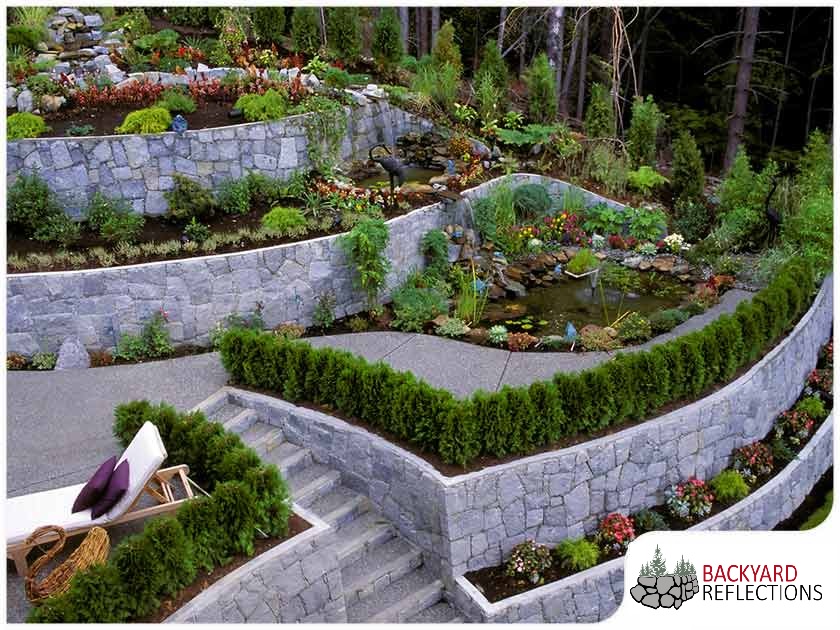Trick Factors To Consider for Structure Effective Retaining Walls in Your Backyard
When you're thinking about constructing a preserving wall surface in your yard, it's vital to believe regarding numerous vital aspects. The wall surface's objective, the materials you'll use, and the details dirt problems can all influence its efficiency and durability. You'll also require to navigate local structure codes and prepare for proper water drainage. How do you ensure your style not just satisfies these requirements yet also boosts your landscape? Allow's check out the essential steps with each other.
Comprehending the Purpose of Your Retaining Wall
When you believe concerning developing a preserving wall, consider its primary objective: maintaining soil and stopping disintegration. Retaining walls offer essential assistance for sloped landscapes, assisting to maintain soil stability. You'll locate they're vital in areas where water drainage could or else remove soil, leading to pricey repairs and landscape damage.
By holding back planet, these walls develop level surfaces for gardens, outdoor patios, or paths. This not just boosts your yard's aesthetics but likewise promotes much better water drainage, reducing water pooling in unwanted areas. If you're taking care of high inclines, a sound retaining wall surface can protect against landslides, guaranteeing safety for you and your building.
Eventually, recognizing the function of your retaining wall will direct your style decisions and assist you create a functional, sturdy structure that meets your needs. Take a minute to evaluate your landscape; it'll pay off in the long run.
Choosing the Right Materials
When selecting products for your retaining wall surface, you'll intend to take into consideration durability, aesthetic appeals, and expense. Each factor plays an essential role in ensuring your wall stands the examination of time while looking terrific and suitable your budget plan. Allow's check out how to make the very best options for your project.
Material Longevity Variables
Choosing the ideal materials is vital for the durability and efficiency of your retaining wall surface, considering that their longevity directly affects the wall surface's capacity to hold up against environmental anxieties. Beginning by considering your neighborhood environment; materials like concrete and stone resist moisture and temperature variations well. If you live in an area susceptible to hefty rainfalls, go with products with good drainage properties, like crushed rock or permeable blocks, to avoid water buildup.
Additionally, think of the soil conditions on your home. Some materials execute much better in details soil kinds, so it is necessary to match them appropriately. Be mindful of potential wear from bugs or disintegration. Selecting long lasting products guarantees your retaining wall surface stands solid, securing your backyard for years to find.
Visual Design Options
Sturdy materials not just ensure your retaining wall's architectural stability but also play a vital duty in its visual appeal. Don't neglect regarding the wall's form-- rounded walls can develop a softer appearance, while straight lines can feel a lot more organized. By very carefully selecting products that line up with your aesthetic vision, you'll enhance your exterior area while ensuring your wall surface stands solid versus the elements.
Cost-Effectiveness Evaluation
Picking the ideal materials for your retaining wall isn't simply regarding looks; it's likewise crucial for your budget. When picking materials, take into consideration both upfront prices and lasting durability.
Do not forget to element in maintenance prices. Some materials, like natural stone, can include appeal and require much less upkeep, while others might require routine therapies
Eventually, evaluate the pros and cons of each choice versus your budget and the wall surface's designated objective. Spending wisely in materials now can avoid costly issues down the roadway. Pick products that balance expense and performance successfully.
Analyzing Soil Conditions and Water Drainage
As you begin your project, evaluating dirt conditions and drain is necessary for the success of your retaining wall. Beginning by checking out the sort of soil in your yard. Sandy dirt drains pipes well yet does not have security, while clay dirt can keep moisture, resulting in pressure on your wall. Examine the dirt's wetness web content by digging a tiny hole and observing just how promptly it dries out.
Next, analyze the slope of your backyard. If water normally flows toward your wall, you'll require to carry out a drainage remedy to avoid erosion and stress accumulation. Think about installing perforated pipelines or gravel backfill behind the wall surface to assist in drainage.
Last but not least, observe any kind of neighboring trees or plants; their origins can affect dirt stability. By comprehending your dirt conditions and applying appropriate water drainage, you'll create a strong foundation for your retaining wall surface that stands the test of time.
Adhering To Local Building Ordinance
Before you begin building your retaining wall surface, you require to study local guidelines to ensure conformity. It's necessary to recognize what permits you should obtain, as this can save you from costly fines or having to renovate your work. article Taking these steps seriously will help you build a risk-free and reliable structure.
Research Study Local Regulations
Understanding local regulations is essential when intending your retaining wall surface task, specifically since building codes can vary significantly by location. Start by getting in touch with your regional building department or community to discover specific requirements. Try to find guidelines on wall surface height, materials, water drainage systems, and structural integrity. Many locations have constraints on the sorts of products you can utilize and how high you can develop. You'll likewise intend to take into account the zoning regulations that may impact your project. Ignoring these laws can bring about pricey fines or the need to redo your job. By doing your research study upfront, you can guarantee your retaining wall surface meets all necessary codes and blends flawlessly right into your yard.
Get Necessary Authorizations
When you've investigated local guidelines, the next action is to get the needed licenses for your retaining wall job. This procedure guarantees your wall follows building ordinance and safety and security requirements. Reach out to your neighborhood structure authority to discover what permits you need. They might need specific plans or design assessments, particularly for larger walls. Be prepared to send comprehensive illustrations, including measurements and materials. Do not forget to check if your task impacts water drainage or neighboring residential or commercial properties, as these elements could call for additional permits. Protecting the ideal authorizations can save you from expensive fines or having to dismantle your wall surface later on. Bear in mind, adhering to the rules now will certainly bring about a smoother building experience.

Planning the Design and Aesthetic Appeal
As you commence planning the design and appearances of your retaining wall surface, take into consideration exactly how it will harmonize with the bordering landscape. Think of the materials you'll make use of-- rock, block, or concrete-- and how they'll enhance your home's style and the natural environments in your backyard. Select colors and textures that mix effortlessly with existing features like patio areas, paths, or gardens.
Following, visualize the wall's shape and elevation. Rounded walls can soften an inflexible landscape, while straight lines might share an extra contemporary look. Don't forget to incorporate plants and greenery around the wall for an all-natural touch; this can enhance its appeal and integrate it right into the environment.
Last but not least, bear in mind performance. Your style ought to not just be visually pleasing yet also offer its function efficiently. By attentively preparing these components, you'll produce a retaining wall surface that enhances your lawn's beauty while satisfying its architectural role.
Determining Elevation and Thickness Needs
To develop a tough retaining wall, you require to properly calculate its elevation and density requirements based on the dirt problems and the height of the incline it will certainly support. Beginning by evaluating the slope's angle and the kind of soil, as different dirts apply differing amounts of pressure.
For walls over 4 feet high, take into consideration a density of at the very least 12 inches. If the wall surface is taller, enhance the thickness proportionally to keep here are the findings security.
Following, calculate the height of the wall by gauging the vertical range it needs to keep. For every single foot of height, you ought to commonly prepare for a thickness of one-third of the wall's elevation.
Constantly bear in mind to make up additional factors like drainage and backfill, which can influence your wall surface's style. Correct estimations currently assure your retaining wall surface stands solid and lasts for several years ahead.
Upkeep and Longevity Considerations
While maintaining your retaining wall might look like a reduced top priority, disregarding it can result in considerable problems gradually. Routine assessments are essential; look for splits, protrudes, or any signs of water damages. Resolving these troubles early can conserve you from expensive repair work down the road.
Keep an eye on drainage systems, also. Clogged drains pipes can create water to accumulate, putting in pressure on your wall and endangering its security. Clear debris and guarantee correct circulation to maintain longevity.
You might additionally intend to review securing your wall to shield it from wetness and weathering. Relying on the material, this could require reapplication every couple of years.
Lastly, landscape design around your wall surface can sustain its integrity. Stay clear of growing large trees nearby, as their origins can weaken the structure. With positive maintenance, your retaining wall surface can serve you well for years ahead.

Regularly Asked Questions
Can I Develop a Retaining Wall by Myself, or Should I Work with a Professional?
You can certainly construct a keeping wall surface yourself if you have the right devices and expertise. Working with a professional assurances it's done appropriately, especially for larger or even more complicated frameworks. Consider your skill level prior to determining.
What Are the Many Usual Mistakes Made When Building Retaining Walls?
When developing retaining walls, you might ignore correct drainage, skip utilizing the appropriate products, or neglect reinforcement. These typical from this source blunders can result in structural failing, so take your time and strategy meticulously to avoid issues.
Exactly how Do I Know if My Retaining Wall Requirements Support?
You'll recognize your retaining wall needs reinforcement if you discover fractures, leaning, or bulging. Look for water merging behind it or dirt disintegration near the base. Address these indications without delay to stop further damage.
What Plants Are Suitable for Landscaping Around a Retaining Wall?
When landscaping around a keeping wall, think about making use of low-maintenance plants like succulents, decorative grasses, or creeping ground covers - OKC Precision Retaining Walls. They'll thrive in those conditions and include elegance while protecting against dirt disintegration around your wall
Exactly How Can I Stop Disintegration Around My Retaining Wall?
To stop erosion around your retaining wall, you can plant ground cover, usage compost, and set up water drainage systems. Frequently examine for water accumulation and change landscaping to reroute drainage away from the wall.
Comments on “OKC Precision Retaining Walls and landscape lighting: Combining function and flair”